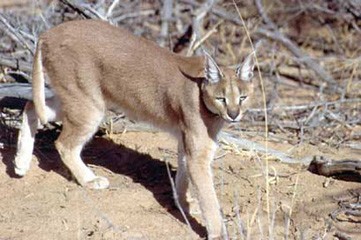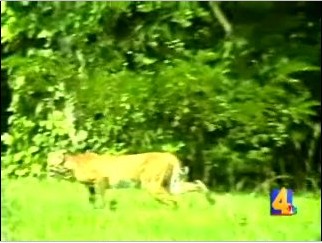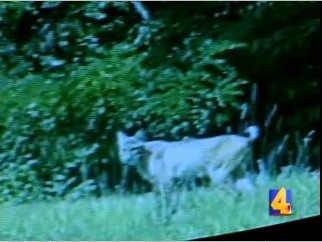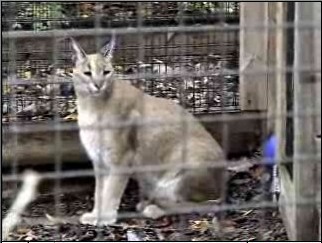Caracal in Nashville?
Posted by: Loren Coleman on November 19th, 2006

Local officials in Nashville, after viewing video (see update below) showing the mystery cat in Warner Park, has identified the felid as an African caracal (above) or an Eurasin lynx, according to the Tennessean. Not a cougar. There seems to be a bit more of a push to the caracal theory than any other.
However, perhaps the wildlife officials have come up with a bit more exotic explanation than they should have? As one comment at the newspaper site reveals:
I have viewed the video of the cat in Warner Park shown on Channel 4 TV news. It is definetly a Eurasian lynx and not an African Caracal. The caracal is quite a different looking cat and has a much larger tail than a lynx. This cat has a small tail which curls upward while a Caracal has a tail about a foot long which hangs downward. A caracal could not curl its tail upward if it tried. The ears are also quite distinctive of a lynx whereas caracal has larger ears with much longer ear tufts. The Eurasian lynx is not native to this area so it is obviously an escaped pet. While a caracal is not well suited to Tennesse winter weather, the lynx would find our winters mild. If it has not been declawed it should have little trouble hunting food in the park. While the Eurasian lynx is the largest of the lynxes and is capable of bringing down a deer, they are not at all aggresive to people so this cat poses no danger.
I must ask: Why not a Canadian lynx? Maybe it’s a rather large male tom bobcat?
I look forward to posting a captured image from the Nashville (cats) video here (which I am certain a helpful Cryptomundo correspondent will email soon), so I can make a more informed guess.
In the meantime, I want to thank Joan Woodward for sending along a message that there’s been a third reported sighting of a big mystery cat in the general Andrews AFB area outside of Washington, D.C., since April 27, 2006.
======UPDATE=======
The first two images below are from the video taken of the Tennessee Mystery Cat; the bottom two are of comparative photos of a captive caracal.




In general, lynx have a black tip on their tail and bobcat have black bands and spots on their body. However, the spotted fur on lynx and bobcat is infrequently rather plain in some specimens. Here is a photograph (below) of an Ohio bobcat. The state of Ohio is located just north of Tennessee.

About Loren Coleman
Loren Coleman is one of the world’s leading cryptozoologists, some say “the” leading living cryptozoologist. Certainly, he is acknowledged as the current living American researcher and writer who has most popularized cryptozoology in the late 20th and early 21st centuries.
Starting his fieldwork and investigations in 1960, after traveling and trekking extensively in pursuit of cryptozoological mysteries, Coleman began writing to share his experiences in 1969. An honorary member of Ivan T. Sanderson’s Society for the Investigation of the Unexplained in the 1970s, Coleman has been bestowed with similar honorary memberships of the North Idaho College Cryptozoology Club in 1983, and in subsequent years, that of the British Columbia Scientific Cryptozoology Club, CryptoSafari International, and other international organizations. He was also a Life Member and Benefactor of the International Society of Cryptozoology (now-defunct).
Loren Coleman’s daily blog, as a member of the Cryptomundo Team, served as an ongoing avenue of communication for the ever-growing body of cryptozoo news from 2005 through 2013. He returned as an infrequent contributor beginning Halloween week of 2015.
Coleman is the founder in 2003, and current director of the International Cryptozoology Museum in Portland, Maine.










I’ll just hope they either catch it alive or don’t find it at all. Be a shame to kill it no matter what kind of cat it is.
I took a picture of a bobcat …. that is my guess. Don’t have a lynx to compare. The undercoat is the same white color, same facial features, same paws … only difference is my picture shows spots along backside and blackish markings on face and is more of a rusty orange color. Believe these come in all colors and although my picture looks like an adult, I have heard that they can lose these markings as they come into maturity from baby to adult.
I am beginning to wonder if not all but some of the big cat sightings throughout the country now are just escaped or released pets. If so many people have poor judgment to release anacondas(and by some reports cobras) and other large animals into the Everglades and other area of Florida, it can happen anywhere.
Just guessing on the scale with grass and twigs, bobcats do get this big.
Google up channel 4 , 2 or 5, Nashville television stations, WSMV, WKRN, and they have posted video of the cat. It is not a bobcat or lynx, but pretty well looks like a Caracal. It is huge, and a beautiful cat. It is wandering around a very large Metro Nashville Park, several hundreds of acres with plenty of water and critters to eat.
But what kind of footage are these stations showing? Isn’t that a captive caracal that they must have used to illustrate what they think they have…this mystery cat hasn’t been caught…right?
Bobcat I took a picture of was close to 3 feet sitting down on hind legs if I remember right.
I googled “channel 4 nashville”, and there is video there, it’s very blurry but at one point during the piece, they show a still frame and it can be seen quite clearly. the actual video of the cat last only about 3-4 second, then it runs out of frame to the left. This cat was a lynx of some sort, definately not a caracal, the tale is short and curls up.
Caracals can move their tails as well as any other cats.
I haven’t seen the pictures of the Nashville feline yet, but it would not surprise me in the least to know that a caracal could be wandering around Nashville (or anywhere else in North America for that matter). Lots of people keep them as pets, and after the cats get to be about a year old the people realize that they have bitten off more than they can chew, and “release” them.
A caracal does not make a good pet for the average person, although they have been kept as pets and for hunting in parts of Africa and Asia for centuries. But caracals are extremely strong, fast, and agile, and they have a sort of bad attitude (much like a bobcat’s) after they mature. They can be really sweet cats, but they do like to have their way, and they can be really aggressive (especially towards dogs).
There are people who are breeding caracals with servals, which are real sweeties when they are raised as pets from kittens, in order to produce a large hybrid cat with the beauty of the caracal, a spotted coat, and a sweet temper. Some of these cats have been crossed with Bengal cats, producing a four-way hybrid (domestic cat/leopard cat/serval/caracal).
Of course, it’s much more likely that a long-legged, short-tailed cat in the Nashville area is a bobcat, since they are native to that region.
Looks like a pretty obvious bobcat to me. Bobcats in warmer parts of the US often have this lanky appearence due to having shorter fur and some bobcats do have very faint spotting that gives the appearence of a more solid colored coat.
The tail is too weird looking for a Bobcat, and this critter is not too shy. It has been seen frequently around this large park, keeping it distance but obviously not too scared of people and cars. A bobcat would be a more skittish.
IMHO its a caracal, but the tail has me puzzled. In all my years in the woods, I’ve only seen 4 bobcats and they were always going 90 miles per hour, and were seen at dawn or dusk. The Nashville cat is being seen at midday, very much like some pet that was released.
After looking at the two photos of the mystery cat, I’d have to say that it looks more like a Eurasian (aka Siberian) lynx than a caracal. Its ears do not seem to be long enough in proportion to its face to be a caracal, and the face in photo 2 appears to have side ruffs, which caracals do not have. Its face looks longer than a bobcat’s face. That’s the easiest way for me to immediately differentiate lynxes from bobcats. Lynxes have a longer face top to bottom, more like a big cat’s face, while bobcats have a shorter face, more reminiscent of a domestic cat face. Caracals’ faces are shaped completely differently from lynxes’ or bobcats’. Caracals’ faces are longer front to back than either a bobcat or a lynx, sort of like a Siamese cat’s face.
Also notice the eyes. The eyes of the mystery cat seem to be clear and light-colored, like a lynx’s eyes. Bobcats’ eyes are usually a darker amber color than a lynx’s, and caracals’ eyes are darker still, almost brown, plus caracals have eyelids that shadow the eye, making the eyes photograph even darker.
The animal in these photos is built like a Eurasian lynx too: tall and lanky. Canada lynxes are a lot smaller than Eurasian lynxes; they are about the size of bobcats but their feet are a lot bigger. There aren’t nearly as many Canada lynxes in private ownership as Eurasian lynxes. I don’t know if they are more difficult to breed or keep in captivity, or what, but while there are several people in the US and Canada who breed and sell bobcats and Eurasian Lynxes, very few sell Canada lynxes.
There is a lot of variation in bobcats, size as well as color variation. I saw one male roadkilled bobcat that was probably 28 inch at the shoulder, with a front paw almost as wide as my hand. But the proportions of this cat are more lynx-ish, going by these two photos. From these photos, I don’t think it’s a caracal.
The site has been updated with new comparative images.
Kittenz- These hybrids are being called Servacals, right?
Photograph I took of bobcat has a much longer face then the one depicted in the example. My photograph matches up perfectly with the bobcat on the loose, same face shape length, width, everything. The ears on the loose ‘bobcat?’ are just a tiny bit different as they are just a ‘tiny’ bit more pointed with an odd butterfly appearance.
The ears in the example photo of bobcat do have that butterfly appearance if you look at the left ear.
My photo doesn’t show the tail but after seeing the ear, I say bobcat!
Being from NY we were overrun with Bobcats. I have to say that just from looking at the photo shown it seems to be just a large bobcat in a short hair coat. I did Wildlife rehabilitation for a few years and had a couple Bobcats. They are truly very lean built animals and only appear to be buff because they are usually seen with their winter pelts. That is when you can hunt and trap them and their fur is worth the most. I just hope they do not do anything rash like try to kill the feline since it poses little to no threat to the surrounding population.
Hello folks, I live in Clarksville, TN about a 40 minute drive from Nashville. 3 or 4 years ago a lady from town here left her cages unsecured and one of these cats got loose around the Smith Branch area. it was never caught. I have no idea of this type of feline’s travel habits, but maybe it is the same one.
Definitely not caracal.
Bobcat. Or Eurasion lynx, although I’m guessing former.
Why can’t people learn that wild predators aren’t pets?
Despite the fact that they say these won’t attack people, this still kinda freaks me out. I drive through this park everyday going to work (in fact, I work across the street from that golf course). There is an excellent walking park at the south end of this park that my wife and I go to every week. As much as I think it would be cool to see one of these, I really don’t want to see it while I’m out walking!
um, where do you think domestic animals came from in the first place? One of the unique things about humans is that we can domesticate animals.
I’m glad that “local officials” are now experts on old world cats. Come on, any conclusion other than a bobcat is completely ridiculous. The only thing that would lead one in the other direction is what looks like unusually short fur. However, there is no justification for ruling out intraspecific variation in favor of the bizarre introduction of an exotic species.
The offspring of serval x caracal are called either caravals or servacals.
The females of either cross can be mated back to males of either parent species, or to domestic toms.
Caracal in Carolina?
The servals/caracals here would explain the new cat I’ve been trying to photograph before mentioning. Critter lives on the outskirts of White Lake, and has had several standoffs with deer on bait piles (all witness thus far have reported the fights ended as draws). None of my hunting friends have popped him, because of (a) range, (b) speed, and (c) the “what the heck is that?” factor.
Note: less than a year ago two miles away, an exotic pet store went out of business (thankfully-law enforcement now working on his zoo).
The bum left behind pythons which froze to death, released mice, hamsters and gerbils into the nearby woods, and (ta-DA!) had several exotic cats as well as three coatimundi. He used to chain the liger up out front where it could harrass deerdogs.
Makes me wonder if he turned out his funky cats, too, and they’ve taken to deer hunting. I’ve seen young Bobcats have to learn the hard way that even a small deer is tougher than he looks.
Svnt.,
Jeff
Is it possible that the large number of median size tan or lite brown cats with longer than bobcat length tails & pointed ears are African Caracals & not mountain lions or pumas in the east. Here are a few questions:
1) Did this caracal have a passport to get into the U.S?
2) How did a Eurasian lynx get videotaped in northern Penna. 6 years ago?
3) Does a Ky Cattery have anything to do with these strange U.S. alien cats?
John A. Lutz, Eastern Puma Research Network